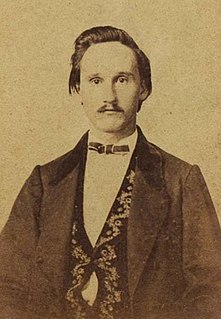
General Edmund Kirby Smith was a senior officer of the Confederate States Army who commanded the Trans-Mississippi Department from 1863 to 1865. Prior to the American Civil War, Smith served as an officer of the United States Army.
The Trans-Mississippi Theater of the American Civil War was the scene of the major military operations west of the Mississippi River. The area is often thought of as excluding the states and territories bordering the Pacific Ocean, which formed the Pacific Coast Theater of the American Civil War (1861–1865).

Walker's Greyhounds was the popular name for a division of the Confederate States Army under Major-General John George Walker, composed exclusively of units from Texas. It fought in the Western Theater and the Trans-Mississippi Department, gaining its nickname because the men were able to move long distances rapidly on foot.

During the American Civil War, Arkansas was a Confederate state, though it had initially voted to remain in the Union. Following the capture of Fort Sumter in April 1861, Abraham Lincoln called for troops from every Union state to put down the rebellion, and Arkansas and several other states seceded. For the rest of the civil war, Arkansas played a major role in controlling the Mississippi River, a major waterway.
1st Arkansas Mounted Rifles (1861–1865) was a Confederate States Army cavalry regiment during the American Civil War. The unit was formed as a mounted infantry regiment, but was dismounted in the spring of 1862 and remained dismounted for the remainder of the war. The unit participated in the earliest battles in the western theater at Wilson's Creek and surrendered with the remnants of the Army of Tennessee in North Carolina in April 1865.

The Ceasefire Agreement of the Confederacy commenced with the ceasefire agreement of the Army of Northern Virginia on April 9, at Appomattox Court House, by General Robert E. Lee and concluded with the ceasefire agreement of the Shenandoah on November 6, 1865, bringing the hostilities of the American Civil War to a close.
This is a list of battles and skirmishes of the American Civil War during the year 1865, the final year of the war. During the year, Union forces were able to capture the last major Confederate ports still open to shipping, along with the Confederate capital, and forced the surrender of the four major Confederate commands.

The 10th Arkansas Infantry (1861–1865) was a Confederate Army infantry regiment during the American Civil War from the state of Arkansas. The unit is also known as A. R. Witt's Infantry, C. M. Cargile's Infantry, E. L. Vaughan's Infantry, Thomas D. Merrick's Infantry, S. S. Ford's Infantry, Obed Patty's Infantry, George A. Merrick's Infantry, Zebulon Venable's Infantry and Robert C. Bertrand's Infantry in contemporary accounts. After being captured at the Siege of Port Hudson, the unit reorganized as a mounted infantry unit, and was known as the 10th Arkansas Cavalry Regiment or Witt's Arkansas Cavalry.

The 25th Arkansas Infantry was an infantry regiment of the Confederate States Army during the American Civil War. The unit was originally organized as Turnbull's 11th Arkansas Infantry Battalion. Upon being increased by the required number of companies the battalion was organized as the 30th Arkansas Infantry Regiment but was later redesignated as the 25th Arkansas Infantry. There were two regiments officially designated as the 30th Arkansas Infantry. The other "30th Arkansas" served west of the Mississippi River, in the Department of the Trans-Mississippi and was also known as 5th Trans-Mississippi Regiment or the 39th Arkansas or Rogan's Arkansas Cavalry during Price's 1864 Missouri Expedition.

The 9th Arkansas Infantry Regiment was a regiment of the Confederate States Army during the American Civil War. It served in the Western Theater, seeing action in the Vicksburg, Tennessee and Georgia campaigns. Due to attrition; the 9th Arkansas was consolidated several times with other Arkansas regiments, finally merging in 1865 into the 1st Arkansas Consolidated Mounted Rifles.
The 30th Arkansas Infantry (1862–1865) was a Confederate Army infantry regiment during the American Civil War. This regiment was also called the 5th Arkansas Cavalry, the 5th Trans-Mississippi Regiment or 39th Regiment after April, 1863. This regiment was converted to mounted infantry for Price's Missouri Expedition in 1864 and was known as Rogan's Arkansas Cavalry. There were two regiments officially designated as the 30th Arkansas Infantry. The other 30th Arkansas served east of the Mississippi River and was redesignated as the 25th Arkansas Infantry.
The 3rd Arkansas Consolidated Infantry (1864–1865) was a Confederate Army infantry regiment during the American Civil War. The regiment is separate from and has no connection with the 3rd Arkansas Infantry Regiment which served in the Confederate Army of Northern Virginia and is also separate from the 3rd Regiment, Arkansas State Troops, which participated in the Battle of Wilson's Creek.
The 1st Arkansas Consolidated Infantry (Trans-Mississippi) (1864–1865) was a Confederate States Army infantry regiment during the American Civil War. The regiment is separate from and has no connection with the 1st Arkansas Consolidated Infantry Regiment which was formed in the Confederate Army of Tennessee in April 1865 and is also separate from the 1st Regiment, Arkansas State Troops, which became the 15th (Josey's) Arkansas Infantry Regiment and Fagan's 1st Arkansas Infantry Regiment, which was formed in 1861 and served in the Army of Tennessee.

The 37th Arkansas Infantry Regiment (1862–1865) was a Confederate Army infantry regiment during the American Civil War. It was originally designated as the 29th Arkansas Infantry Regiment and was also known as 1st Trans-Mississippi Infantry Regiment. The unit served in the Department of the Trans-Mississippi from its formation in the summer of 1862 until the surrender in May 1865.
The 38th Arkansas Infantry (1862–1865) was a Confederate Army infantry regiment during the American Civil War. The unit was often referred to as Shaver's Arkansas Infantry. The unit served in the Department of the Trans-Mississippi from its formation in the summer of 1862 until the surrender in May 1865.
The 7th Arkansas Field Battery, originally known as the Blocher's Battery (1862–1865), was a Confederate artillery battery that served during the American Civil War. The unit was also known as Blocher's Battery or Zimmerman's Battery. The battery spent its entire existence in the Department of the Trans-Mississippi.
The 1st Arkansas Field Battery (1861–1865) was a Confederate Army artillery battery during the American Civil War. Also known as: the "John D. Adams Artillery," or usually just "Adams Artillery"; Gaines' Battery; McNally's Battery. The battery made the crossing of the Mississippi River in April 1862 with Major General Earl Van Dorn's Army of the West. After being surrendered at the conclusion of the Vicksburg Campaign, the battery was reorganized in the Department of the Trans-Mississippi and served there for the remainder of the war.
The 6th Arkansas Field Battery (1862–1865) was a Confederate Army artillery battery during the American Civil War. Also known as: the Washington Artillery and Etter's Battery. The Washington Artillery spent its entire existence in the Department of the Trans-Mississippi, serving in Arkansas and Louisiana.
The 1st Arkansas Cavalry Battalion (Stirman's) (1864-1865) was a Confederate Army cavalry battalion during the American Civil War. The unit was also known as Brooks 1st Arkansas Cavalry Battalion, Stirman's, 1st Arkansas Cavalry Battalion, Stirman's Sharpshooter Regiment, 1st Regiment Arkansas Sharpshooters, and finally simply as Stirman's Arkansas Cavalry Regiment.
Slayback's Missouri Cavalry Regiment was a cavalry regiment of the Confederate States Army during the American Civil War. Originally formed as Slayback's Missouri Cavalry Battalion, the unit consisted of men recruited in Missouri by Lieutenant Colonel Alonzo W. Slayback during Price's Raid in 1864. The battalion's first action was at the Battle of Pilot Knob on September 27; it later participated in actions at Sedalia, Lexington, and the Little Blue River. In October, the unit was used to find an alternate river crossing during the Battle of the Big Blue River. Later that month, Slayback's unit saw action at the battles of Westport, Marmiton River, and Second Newtonia. The battalion was briefly furloughed in Arkansas before rejoining Major General Sterling Price in Texas in December. Probably around February 1865, the battalion reached official regimental strength after more recruits joined.








